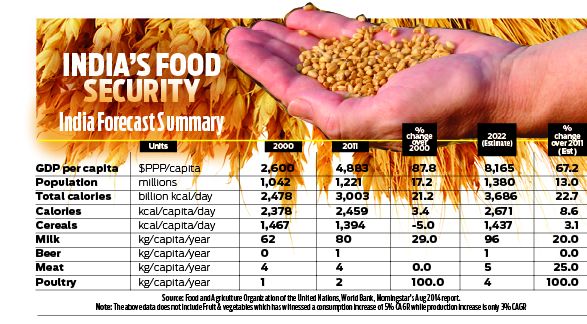
At first blush, there is a lot to be cheerful about. India’s index of industrial production has resumed its climb. Stalled projects are being dusted and revived. There is a good chance that employment figures, too, will begin rising by the end of the next quarter.
Then there is more good news. Per capital GDP (Gross Domestic Product) on the price purchase parity (PPP) basis is likely to continue climbing to touch $8,165 by 2022. It grew by 88% during the 2000-2011 period, from $2,600 in 2000, to $4,883. The coming decade could see it soar by another 67% (see chart). Moreover, the country’s granaries are full and overflowing. The rains were not as bad as were feared earlier. Consequently, India could see a decent harvest this year as well.
Further, with increasing affluence, total calorie consumption too has swelled (see chart). As economists often point out, when salary levels are low, much of income goes towards food. Extremely poor families spend as much as 80% of their income on food (India’s average spending on food is around 45%). However, as incomes rise, the percentage on food spends begins declining. People are now in a position to fulfil other needs as well. Additionally, while earlier people focussed on how much they ate, higher incomes make people consider carefully what they would like to eat. The plate begins to add more nutrition.

The clouds gather . . .
This is where the policy mismatch begins to show up. If cereal consumption is declining, why is India continuing to purchase cereals — even when granaries are overflowing — often at higher than international prices? Remember, government procurement is a benefit only rice and wheat enjoy. Other agricultural products enjoy minimum support prices (MSPs), but are not guaranteed offtake by government agencies.
In sharp contrast, demand for millets, vegetables and fruit, milk and meat have been increasing. Clearly, the government needs to do a rethink. The old penchant for succumbing to political compulsions of north India — which often overtook common sense — may have to be abandoned.
Compounding this is another fact — even though India is the world’s second largest producer of fruit and vegetables (240 million tonnes), almost 35% of this is allowed to go waste. This is because of the absence of good logistics (including good roads), food preservation and processing facilities and easy access to markets. Worse, even while consumption of fruit and vegetables has been growing at 5% CAGR, production has been increasing at just 3% per annum.
The milk miracle
It appears that India’s policymakers have lost the vision that helped create the biggest agro-success-story the country has witnessed — milk. Do remember that India’s milk production in 1951 was just 17 million tonnes of milk while, at that time, the US notched a figure of 56 million tonnes. Today, India is the world’s largest producer of milk at 136 million tonnes, while the US has seen its production grow to just around 92 million tonnes.
In fact, the milk juggernaut rolls on. The last decade saw milk consumption soar by 29% — faster than food — while the coming decade will see it soar by another 20% (see chart). All this growth happened without much private sector investment. There aren’t many owners of hundreds of heads of milch cattle. Almost 80% of the milk producers have just 2-4 cows. What changed the destiny of milk was a man called Dr Verghese Kurien. He created the milk cooperative movement. To finance the creation of the milk infrastructure, he persuaded the central government to allow him to monetise food aid from Europe and the US. This money was ploughed back into creating the required infrastructure — for procuring milk from small producers, transporting it into chillers, and then to the processing plant and thereafter to consuming cities, all within 24 hours. Money for financing infrastructure can always be found. What’s needed is the vision and the will.
Policy gaps
India needs to find the money to create the infrastructure for reaching fruit and vegetables to the markets — that means better roads and access to markets. Money is needed for food processing facilities and food preservation, because almost 35% of the total output of vegetables and fruit gets wasted and spoilt.
For this too, money can be found. After all, the country spends over $12 billion on fertiliser subsidy, an equal amount on power subsidy and around $20 billion on food subsidy. Some of it can be used to pay for agricultural research, logistics, and food processing infrastructure. One way to do this is by linking subsidies and incentives to water and energy consumption. This is because the next crisis facing the country is water. All indicators show that India’s water shortage is likely to soar to 50% by the end of 2030 — three times more than the gap that a water-starved China is likely to face. This is despite India being at least three times more abundant in water resources and availability than China.
A profligate India also uses up more ground water than its neighbours. And in spite of using this water on more land than China has for agriculture, the latter produces more crop than this country.
All these need to be addressed urgently. We will have to learn to produce more food, but with less land, less fertiliser, less pesticides and less water. And we are running out of time. By 2030, India’s population will have exceeded that of China making it the most populous nation in the world. A large population — highly aspirational, increasingly urbanised, hence capable of organised protests in densely packed cities — will be confronted by both food and water shortages. That is a perfect recipe for social unrest.
If nothing is done quickly, food and water riots could be round the corner.
The author is a consulting editor with dna